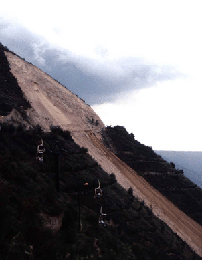Mass movements
Different types of mass movements occur such as landslides or solifluction.
In general, mass movements starts if the critical shear stress is reached. When this occurs depends on characteristics of material and slope steepness. The steeper the slope the faster the critical shear stress is reached (see Coloumb rule).
You’ll find a more detailed explanation of mass movements in German if you follow this hyperlink.
As areas of steep slope occur often in the Gina River catchment mass movements are frequent. They are aggravated by land use activities and cattle treat with a negative effect on the characteristics of material (e.g., soil compactness). These dominant processes – soil erosion and mass movements – cause an area-wide pattern of soil sediments covering the saprolite with a sharp boundary. Thus, most of the soils in the Gina River catchment did not develop in-situ.



